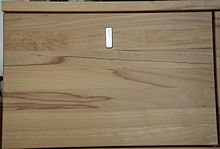Core beech
As beech heartwood denote Tischler the wood of the beech ( Fagus sylvatica) when dark, having wood-like core, cloudy discoloration. The synonym wild beech is also common in the furniture industry .
However, it is not heartwood in the actual sense of the word, as occurs in real heartwood trees such as oak or larch , but rather so-called false heart ( beech red heart ).
The carpenter calls common beech wood red beech because it has a slightly more reddish tone than the wood of the hornbeam ( Carpinus betulus ), which is accordingly called white beech . In the botanical sense, the hornbeam is not a beech, but more closely related to birch and hazelnut , which also form a very light wood.
The wood, known as heart beech, has a noticeable and livelier grain than normal beech wood and has a significantly darker tone. On the contrary, common red beech wood is characterized by a very even and inconspicuous grain.
Between 100 and 140 years of age, brown to reddish, irregular discoloration occurs in the inside of the trunk of some red beech trees, which do not appear concentrically like real heartwood and are surrounded by an annual ring, but have an irregular border. The discoloration is probably a side effect of physiological changes inside the trunk. Only the younger cells in the outer areas of the trunk ( sapwood ) are adequately supplied with water and nutrients. The inner wood layers of the trunk become inactive. The color change may be caused by oxidation processes in the vessels originally used for water transport.
This natural process of change creates a special pattern on the wood. The sometimes wild-looking structure has a decorative effect on the surfaces of furniture. Changes in the properties of the wood such as loss of strength due to the changes are not known, although the discoloration was previously considered a wood defect .
Since only old beeches and only the inner area of the trunk (approx. 10-30% of the usable wood) are affected by the discoloration, the supply is limited. A growing demand in recent years is noticeable in the price.
A red heart on beech used to be seen as a quality disadvantage. In 2001, the price in Baden-Württemberg fell to well below 50%, especially for thick beech trees, when the red core portion exceeded 30% on the upper or lower visible trunk cross-section of a felled tree. Beech wood with a colored core is not used to make railway sleepers because it is difficult to soak.
Origin of the color core
The above-mentioned theory on the origin of the false core is represented by, among others, Hans Heinrich Bosshard in his work Baumkunde . Bosshard tries to grasp the terminology scientifically and introduces the term "facultative heartwood". It describes tree species that do not have a colored core under good growing conditions, but can develop a colored core inside the trunk under certain circumstances. Bosshard assumes that the core formation takes considerably longer with such types of wood than with real heartwood trees (if it occurs at all).
More recent studies by Alex L. Shigo, on the other hand, attribute the formation of false kernels to damage to the bark and other weakening of resistance, whereupon parasites such as fungi and viruses penetrate the tissue of old trees. The change in color of the wood would then be caused by the defense mechanisms of the tree.
Individual evidence
- ↑ Schütt, Schuck, Stimm: Lexicon of tree and shrub species . Nikol, Hamburg 2002, ISBN 3-933203-53-8 , pp. 169 .
- ↑ The red heart in large-crowned beeches (on waldwissen.net)
- ↑ Book on proholz.at ( Memento of the original dated November 16, 2011 in the Internet Archive ) Info: The archive link was inserted automatically and has not yet been checked. Please check the original and archive link according to the instructions and then remove this notice. (accessed on August 21, 2011)
literature
- Hans Heinrich Bosshard: Baumkunde . Volume I-III. Birkhäuser Verlag, Basel 1970.
- Alex L. Shigo: Modern Tree Care. Basis of tree biology . Haymarket Media, 1994, ISBN 978-3-87815-051-0 .

